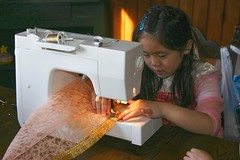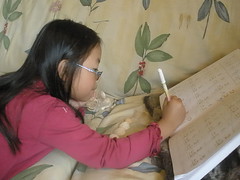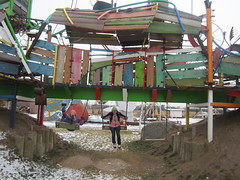Rather, they would spending the majority of their time in their minivan driving around doing errands, shopping for organic produce, building a new home, and playing. I wondered how much the children were actually learning.
A few years later, I found out the father intervened and said that the children had to learn some fundamentals - like how to read and do math. Thankfully, that was a turning point for the family and now the children (from what I heard many years ago) are doing very well.
At that time, homeschooling was not even something I would have remotely considered. Then I founded and ran a non-profit organization that focused on educating children about the connection between nature, agriculture, and the arts. As part of doing the camp and after-school programs, I created lesson plans. I was hooked. I found something I thoroughly enjoyed.
After Sophia and Olivia were adopted and were still young, they were both diagnosed with sensory integration disorder. I knew at that point that going to public school wasn't an option.
As How to Homeschool with Sensory Integration Disorder states, "Children with sensory integration disorders can have a difficult time in a typical classroom environment. When a person's sensory system is not functioning properly certain things, such as the buzzing of an overhead light or an unexpected fire drill, can be nearly impossible to deal with. Everyday events could trigger tantrum and escape behavior in child who cannot process environmental stimuli in a typical manner."
Similar to the article noted above, there are certain things that I do to ensure that homeschooling Sophia and Olivia goes as smoothly as possible:
1. Create a learning environment that works for the girls' sensory needs. They do not have just one place where they learn in the home. I know some families who homeschool have a dedicated "school room." This wouldn't work for the girls. They use multiple rooms depending on what they are working on and how much/little distraction they can handle.
Learning about lung capacity.
(Taken on February 16, 2011)
2. Ensure the home is quiet when they are learning. There always will be distractions because of the indoor pets and seeing birds at the birdfeeders outdoors. However, the level of noise is almost non-existent when they are reading, doing math, or other subjects that require concentration. This is essential for them since their bodies have a difficult time filtering out competing sounds.
Making a rebozo as part of the
Josephia (American Girl) unit study.
(February 20, 2008)
3. Teach the girls at their own pace and not rush them. This is essential. Some subjects are particularly difficult for them and compensations need to be made so they can effectively learn the subject. For example, with 2- and 3-number multiplication or long division, Sophia must use graph paper to line up her numbers. Visually, that is difficult for her to do without the lines.
Using shells to help learn addition facts.
(September 11, 2009)
For Olivia, she uses tangible items - manipulatives - to help with addition and subtraction. The majority of her answers are correct (1 or 2 incorrect on a page), even though it takes her a long time to complete a lesson. She will work on a lesson until she is done. She does not like to start and stop a lesson if it isn't done within a certain time frame. This would be highly frustrating for her.
4. Integrate sensory activities into the day. When the girls were younger, I did this because they were actively involved with therapy. Therapeutic brushing, for example, was done every two hours. They enjoyed this and found it quite calming.
Last year, I attended a homeschool conference and there was a speaker who had excellent ideas about sensory issues. So, this year sensory activities will be a part of our daily schedule. I'm hoping that they help both the girls.
Playing with Oodles of Ooze that I made.
It didn't get the girls' hands dirty
(which they didn't like).
(March 23, 2008)
5. Maintain a schedule. I have a general "flow of the day" schedule that the girls know. This helps give a sense of predictability and helps foster a calmer environment. Both the girls like to know if the schedule will be changed in any way. Sophia will ask the night before what is happening the next day, while Olivia likes to know in the morning what will be happening that day.
The girls swinging on a sculpture at
Franconia Sculpture Park.
This is one of their favorite art pieces there.
(Taken on December 3, 2011.)
That being said, both keep calendars now that they are older so they know when lessons and activities are scheduled.
6. Provide opportunities to connect with others of all ages - not just those at their peer level. This is a very important part of homeschooling, in my opinion. I want the girls to be comfortable interacting with their peers as well as children younger than they are and adults.
Sophia and Olivia at a bakery at a
Mexican restaurant and grocery store.
They had to talk with the person who took their order for lunch
as well as the person at the bakery.
This was following a morning activity at their cousin's high school
that featured Chinese acrobats and
hands-on activities led by high school students
from other countries (international students) with whom who they talked.
(Taken on May 4, 2012.)
Going out and having Sophia and Olivia talk with people of all ages in various settings exposes them to a wide range of people, topics, and conversations. Almost every day they leave the home and do some type of lesson or activity that connects them to others (e.g., homeschool co-op, 4-H, harp lessons, piano lessons, children's choir, equestrian vaulting, special education, errands, field trips).
So, homeschooling has been a good choice for Sophia and Olivia. It fits their learning and sensory needs at home; and keeps them connected to others during a variety of activities throughout the week.








8 comments:
This is such a wonderful article!!!
We have now been homeschooling DD in the basics for 10 weeks and the amount she and I have learned it incredible. I now know she is an arty/practical type rather than a thinker.
I think one to one teaching is the way to go with education rather than a one size fits all attitude.
Have you found many issues with other people not agreeing with homeschooling? I realise in America it is far more common than it is in the UK, but I have found several family members are against the idea.
x x x
Thank you for your kind comment about the article. I'm happy that you're finding that homeschooling is a good fit for your family as well.
You asked about people not agreeing with homeschooling. When I first began, there were more questions and concerns about it than there are now. I think this was because most of the people who expressed a less-than-enthusiastic response did not know any homeschooling families.
Once family, friends, and others could see homeschooling in action, how the girls were learning, and that they were not socially isolated at home 24 hours a day, 7 days a week...then they were/are more supportive of this educational choice.
Homeschooling is becoming much more of a mainstream choice for education because of the many choices available not only in the state, but the country.
It's hard to believe that in the late 1980s it was still illegal. Homeschooling has come a long way; and I'm so grateful that my daughters have that opportunity to learn at home!
I have a dyslexic son whom I have to use different styles of teaching from what I've use with my other 3 kids, and actually some of them are what you do with your girls, distractions are especially hard on him. Have a great school week, we start today!
Great job on the homeschooling! As I read more and more of your blog, I see the many different opportunities that you have given your daughters. In their case, it seems like they are learning more from you then they ever would in a public school setting.
I so agree with your philosophy of introducing the girls to people of all ages. I used to say that children learn to be adults by being with adults, not children.
Do you still offer classes in nature/art? That sounds awesome... coming from this amateur naturalist writer.
Samuel is on the spectrum and has sensory issues as well. I am amazed how much I educate his educators about how this might "show up" in his classroom.
Your girls are blessed to have you... and love the sewing unit/going at your own pace. My mother always finished my sewing projects which taught me I am not capable of sewing. I am not capable of finishing stuff!
I learned, lo and behold, I can do both!
Thanks so much for stopping by Me + the Moon! Happy to find your blog + follow you back! :)
-Nicole @ http://meandthem00n.blogspot.com
Another homeschooler here. It sounds like you are a great homeschool mom! :) Great ideas for activities and for meeting sensory needs. i'm curious about the oodles of ooze... that sounds fun!
Post a Comment